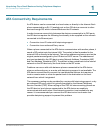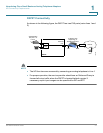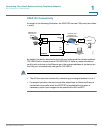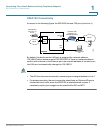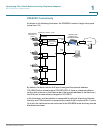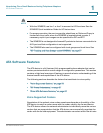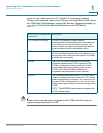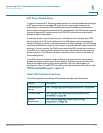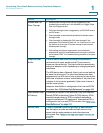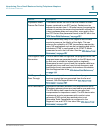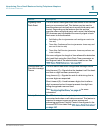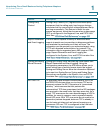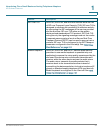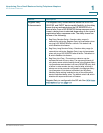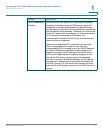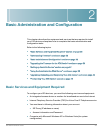
Introducing Cisco Small Business Analog Telephone Adapters
ATA Soft ware Features
ATA Administration Guide 28
1
Modem and Fax
Pass-Through
• Modem pass-through mode can be triggered only by
predialing the number set in the
Modem Line Toggle Code.
(Set in the Regional tab.)
• FAX pass-through mode is triggered by a CED/CNG tone or
an NSE event.
• Echo canceller is automatically disabled for Modem pass-
through mode.
• Echo canceller is disabled for FAX pass-through if the
parameter
FAX Disable ECAN
(Line 1 or 2 tab) is set to “yes”
for that line (in that case FAX pass-through is the same as
Modem pass-through).
• Call waiting and silence suppression is automatically
disabled for both FAX and Modem pass-through. In addition,
out-of-band DTMF Tx is disabled during modem or fax pass-
through.
Adaptive Jitter
Buffer
The ATA device can buffer incoming voice packets to
minimize out-of-order packet arrival. This process is
known as jitter buffering. The jitter buffer size proactively
adjusts or adapts in size, depending on changing network
conditions.
The ATA device has a Network Jitter Level control setting
for each line of service. The jitter level determines how
aggressively the ATA device tries to shrink the jitter buffer
over time to achieve a lower overall delay. If the jitter level
is higher, it shrinks more gradually. If jitter level is lower, it
shrinks more quickly.
Adaptive Jitter Buffer is configured in the Line and PSTN
Line tabs. See “ATA Voice Field Reference,” on page121.
International Caller
ID Delivery
In addition to support of the Bellcore (FSK) and Swedish/
Danish (DTMF) methods of Caller ID (CID) delivery, ATAs
provide a large subset of ETSI-compliant methods to
support international CID equipment. International CID is
configured in the Line and PSTN Line tabs. See “ATA Voice
Field Reference,” on page121.
Secure Calls A user (if enabled by service provider or administrator)
has the option to make an outbound call secure in the
sense that the audio packets in both directions are
encrypted. See ”Secure Call Implementation” section on
page 72.
Feature Description



